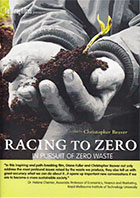
Racing to Zero: In Pursuit of Zero Waste 2014
Distributed by Bullfrog Films, PO Box 149, Oley, PA 19547; 800-543-FROG (3764)
Produced by Diana Fuller
Directed by Christopher Beaver
DVD, color, 55 min.
Middle School - General Adult
Activism, Capitalism, Climate Change, Conservation, Documentaries, Environmentalism, Public Health, Recycling, Sustainability
Date Entered: 12/01/2015
Reviewed by Jen Wong, The University of Texas at Austin Materials LabRacing to Zero provides an inspiring overview of the collective efforts that contribute to the success of San Francisco’s ambitious zero waste goal for 2020. The city currently holds the highest landfill diversion rate in the country – recycling, repurposing, or composting 78% of its waste that would otherwise go to the landfill. In comparison, the nation-wide diversion rate for the United States is around 30%. The film is effective in communicating a central message: that garbage must be regarded as a resource, rather than waste. “I see money in this pile,” says a large-scale glass recycler, pointing to a mound of broken bottles. For viewers unfamiliar with this contemporary approach to resource streams, in which “waste” has significant economic and material value, this message alone is eye-opening.
Though Racing to Zero lacks a strong narrative voice or sleek production quality, the message of waste as resource comes across through reiteration from multiple constituents. The film moves along at a brisk pace, introducing a wide range of public and private individuals - including policy makers, entrepreneurs, residents, waste management workers, and researchers. Each plays a part, and the film clearly demonstrates how each contributes to the city’s goal of zero waste. In doing so, the film conveys the overwhelming scale and significance of a serious environmental issue while providing clear solutions achievable by committed individuals. Although it relies on light anecdotal encounters to tell its story, the DVD is supplemented by two digital resources: a study guide compiled by the director and producer, as well as a 2-page summary of key findings and policy recommendations regarding zero waste.